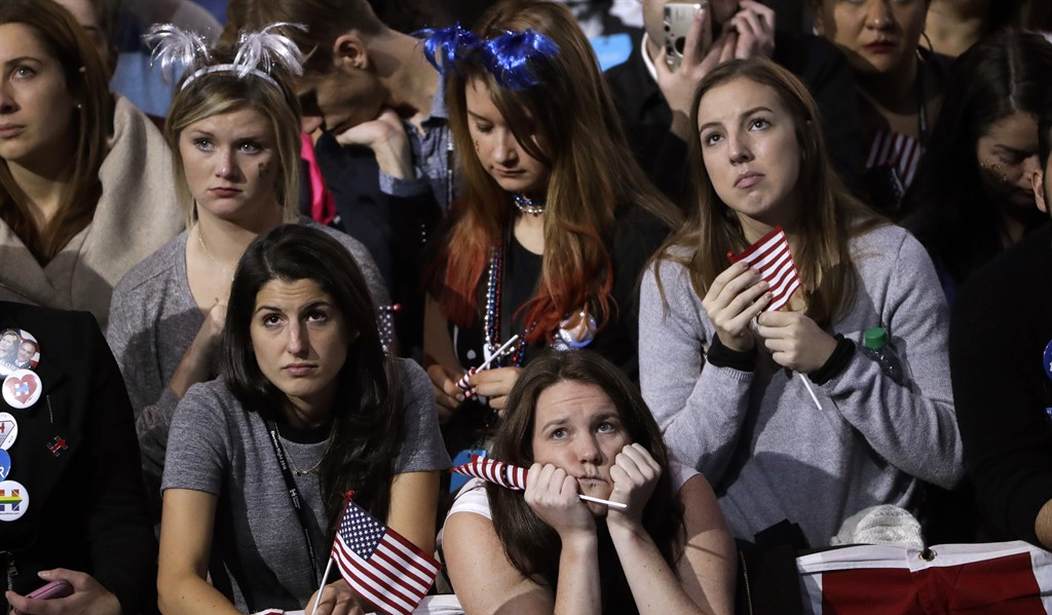Voters might be forgiven if in the closing weeks of the 2020 election cycle they are experiencing a sense of déjà vu. After all, this year, as in 2016, the pollsters are nearly unanimous: the Democrat is way ahead, and the chances for an upset victory by the Republican — who supposedly no one likes — are slim to non-existent. Leftists (and journalists — the two categories largely overlap) are licking their chops, dreaming not just of winning the White House, but of securing the House, the Senate, and the Supreme Court, all in one fell swoop!
What makes our sense of déjà vu tingle with special ferocity is the fact that the polling in 2020 is so darn similar to 2016. RealClearPolitics allows savvy readers to compare polling trends in the battleground states in 2016 versus 2020 in one handy table. The results are shocking. At this point in 2016, Trump's standing in states like Wisconsin, Michigan, Pennsylvania, North Carolina, and Florida was almost identical to what we see today. And, in case anyone has forgotten, Trump was behind in all those states in the average of polls in 2016...and he nonetheless won every single one of them when the votes were counted.
It sure feels, therefore, as though the pollsters and the pundits, who are ready to write Trump off in 2020, are making the same mistakes they made before. Clearly, those of us who want more accurate and reliable predictions of the election results need to look elsewhere. At the very least, we should be willing to consider what other metrics and tools of analysis have to offer.
Among the more whimsical and unscientific options are the forecasts based on seemingly trivial factors: Biden- and Trump-themed cookie sales in suburban Philadelphia, TV ratings for Biden and Trump's dueling town halls, or the prevalence of yard signs for one candidate or the other. Much as we may find these amateur efforts at prognostication amusing, sometimes they fall spectacularly short. In 2016, for instance, "Boots," a Scottish goat famous for his psychic powers, predicted that Hillary Clinton would beat Donald Trump. After that blunder, Boots had to eat his own tartan cap.
Recommended
Another option, if we want to forecast the results in 2020, is to consider the mountains of data about early voting that are already accumulating. Just as in 2016, this year a cottage industry has developed devoted to reading the tea leaves of mail-in and early in-person voting. We don't know, of course, how people have voted, but we do know, in some cases, their party affiliations, their age, their race, and the areas where more or fewer votes are being cast. The problem, however, is that there is so much data on early voting that it can easily be spun one way or the other. There are, in fact, warning signs for both parties in the early vote totals. Therefore, to gain an accurate sense of who has the upper hand — Biden or Trump — we need to look even deeper.
One predictive avenue that more and more people are gravitating towards is “prediction markets.” These are essentially betting markets, in which experts and laymen alike stake their bets on a very wide range of questions, from who will win the U.S. presidential election, to where the Dow Jones will stand at the end of 2020, to when the first coronavirus vaccine will be approved.
Much like how Wikipedia has leveraged the contributions of eggheads worldwide to forge the most successful and influential compendium of knowledge in history, prediction markets accept bets from people from all walks of life (a variant of crowdsourcing), but with one thing in common: they are willing to put their own money on the line to support their forecasting ability. This is, when you think about it, a critical advantage.
Look at it this way: how many “journalists” in the mainstream media make a good living churning out stories about why Democrats are winners and Republicans are losers? How many of them wrote off Donald Trump's chances long ago, despite the fact that he is actually doing better in the battleground state polls in 2020 than he was in 2016?
The truth, of course, is that left-leaning analysts can talk up the Democrats' chances and trash Republicans with impunity because, if they turn out to be wrong — even grossly wrong, as they were in 2016 — there's no semblance of accountability. How many pundits were fired in 2016 because they got everything about that historic election dead wrong? None. In shilling for Hillary Clinton and in downplaying Trump's chances, they literally had nothing to lose.
What if, however, correspondents and talking heads had to stake their careers, or even a small portion of their salaries, on the accuracy of their predictions? What do you think would happen? Would they be equally dismissive of the electoral prospects of Donald Trump and the GOP...or would they think a little harder before they spoke? Would they, in fact, give Trump and Republicans the benefit of the doubt?
The answer is obvious, and it explains why prediction markets are an increasingly attractive option for those wanting an accurate and informed perspective on what is likely to happen in the future. Not surprisingly, while most pundits currently rate Trump's chances of winning as very low, the prediction markets have consistently given him a realistic shot at victory. In fact, they view a Trump win in 2020 as significantly more likely than in 2016. They seemingly have figured out what the pollsters have missed: that this is a fundamentally evenly divided country, in terms of political ideology and partisan leanings. Moreover, the vast majority of our recent elections have been close, so the idea that either party could be out of the running in 2020 is pure bunkum.
And, for those who are intrigued by prediction markets already, there's even more good news: the markets themselves are still in a state of flux.
Just as a poll gets more reliable if you survey a larger number of people, prediction markets' accuracy improves as additional investors/prognosticators join the movement — and prediction markets have been growing their constituency apace.
In addition, new players are trotting on to the field with fresh ideas about how to make prediction markets even more, well, predictive. For example, while venerable markets like PredictIt, Betfair, and Augur continue to offer useful insights and valuable forecasts, in many cases superior to what pollsters have to offer, new and rising companies like Polymarket also show promise. Polymarket incorporates blockchain technology to allow for the democratization of information, meaning greater flexibility and choice for those who place their bets. It is thus a truly free market of ideas — ideas about the future.
The upshot of the role of prediction markets in forecasting the 2020 election is that they consistently rate Donald Trump's chances of victory higher than the professional pollsters do. Whereas Nate Silver gives Trump only a 12% chance of winning, prediction markets say he has roughly one-in-three odds.
Despite all this prognosticating, no one can say for sure who will win the 2020 election. Human behavior is sufficiently mysterious that no model, no formula, can encompass all of its complexities. Be that as it may, anyone who wants a valid forecast of what will happen on Nov. 3rd would be foolish not to consider the prediction markets in combination with early voting data and the polls. Moreover, we should monitor these various sources of insight about future events continuously and closely, because much can change between now and election day. Joe Biden had a good summer, in terms of the polls and the prediction markets, but October may not be as kind. There is already compelling evidence that Trump is closing the gap...and in the swing states there may not be much of a gap to close.
If you are among those who desperately want to know whether America will stay red in November, therefore, or will turn some shade of blue, the good news is that there is more and better information available now on which to base an informed and realistic forecast.
The bad news is that we will still have to wait until all the votes are counted before we know anything for sure.

























Join the conversation as a VIP Member